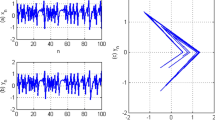Abstract
In this paper, we study the minimum free distance and error performance of turbo encoders with Möbius interleavers. In order to be capable of estimating the minimum free distance of these interleavers using binary-fixed point (BFP) algorithm, new deterministic interleavers called “truncated Möbius interleavers” are defined and constructed. It is shown how the shifted cycles of these interleavers can be related to the cycle structure of the primary Möbius transformation and its coefficients. By adjusting some parameters, an upper bound on the number of total tested BFPs for the proposed truncated Möbius interleavers is found. One distinctive property of Möbius interleavers is that their inverse can also be represented and computed with Möbius functions. Simulations are conducted to compare the error performance of the proposed truncated Möbius interleavers with quadratic permutation polynomial (QPP) interleavers whose inverses are also representable by a quadratic equation (Ryu and Takeshita in IEEE Trans Inf Theory 52(3):1254–1260, 2006). It is finally shown that the truncated Möbius interleavers can interleave sequences of information bits faster than QPP interleavers.





Similar content being viewed by others
References
Berrou, C., Glavieux, A., & Thitimajshima, P. (1993). Near Shannon limit error-correcting coding and decoding: Turbo codes. In Proceedings of international conference on communications (pp. 1064–1070).
Boutros, J. J., & Zemor, G. (2006). On quasi-cyclic interleavers for parallel turbo codes. IEEE Transactions on Information Theory, 52, 1732–1739.
Breiling, M. (2004). A logarithmic upper bound on the minimum distance of turbo codes. IEEE Transactions on Information Theory, 50, 1692–1710.
Cesmelioglu, A., Meidl, W., & Topuzoglu, A. (2008). On the cycle structure of permutation polynomials. Finite Fields and Their Applications, 14(3), 593–614.
Corrada-Bravo, C. J., & Rubio, I. (2003). Deterministic interleavers for turbo codes with random-like performance and simple implementation. In Proceedings of 3rd international symposium on turbo codes, Brest, France.
Crozier, S., & Guinand, P. (2005). Distance upper bounds and true minimum distance results for turbo codes designed with DRP interleavers. Springer Annales Des Tellecommunications, 60(1–2), 10–28.
Daneshgaran, F., & Mondin, M. (2000). Permutation fixed points with applicat-ion to estimation of minimum distance of turbo codes. IEEE Transactions on Information Theory, 46(7), 2336–2349.
Divsalar, D., & Pollara, F. (1995). Turbo codes for PCS applications. In Proceedings of international conference on communications, Seattle, WA.
Garello, R., Pierleoni, P., & Benedetto, S. (2001). Computing the free distance of turbo codes and serially concatenated codes with interleavers: Algorithms and applications. IEEE Journal on Selected Areas in Communications, 19(5), 800–812.
Hosseinalipour, S., Sakzad, A., & Sadeghi, M.-R. (2015). Minimum free distance of \(\text{CCSDS}\) turbo encoders under (truncated) Möbius interleavers. In Proceedings of 3rd Iran workshop on communication and information theory (IWCIT) 2015, Tehran, Iran (pp. 1–6).
LTE; Evolved Universal Terrestrial Radio Access (E-UTRA); Multiplexing and channel coding (3GPP TS 36.212 version 8.8.0 Release 8) (2010–01). Technical specification, European Telecommunications Standards Institute (ETSI).
Mullen, G. L., & Panario, D. (2013). Handbook of finite fields. Boca Raton: Chapman and Hall/CRC.
Nimbalker, A., Blankenship, Y., Classon, B., & Blankenship, T. K. (2008). ARP and QPP interleavers for LTE turbo coding, wireless communications and networking conference, 2008. WCNC 2008. IEEE (pp. 1032–1037).
Perotti, A., & Benedetto, S. (2004). A new upper bound on the minimum distance of turbo codes. IEEE Transactions on Information Theory, 50(12), 2985–2997.
Report Concerning Space Data System Standards: TM synchronization and channel coding summary of concept and rationale (2012). Informational Report CCSDS 130.1 -G-2, Green Book. Consultative Committee for Space Data Systems, Green Book.
Rosnes, E. (2012). On the minimum distance of turbo codes with quadratic permutation polynomial interleavers. IEEE Transactions on Information Theory, 58(7), 4581–4795.
Rosnes, E., & Ytrehus, O. (2005). Improved algorithms for the determination of turbo code weight distributions. IEEE Transactions on Communications, 53(1), 20–26.
Ryu, J., & Takeshita, O. Y. (2006). On quadratic inverses for quadratic permutation polynomials over integer rings. IEEE Transactions on Information Theory, 52(3), 1254–1260.
Sakzad, A., Sadeghi, M.-R., & Panario, D. (2012). Cycle structure of permutation functions over finite fields and their applications. Advances in Mathematics of Communications, 6(3), 347–361.
Sakzad, A., Panario, D., Sadeghi, M.-R., & Eshghi, N. (2010). Self-inverse interleavers based on permutation functions for turbo codes. In Proceedings of 48th annual Allerton conference on communications, control, and computing, Allerton, Chicago, USA (pp. 22–28).
Sun, J., & Takeshita, O. Y. (2005). Interleavers for turbo codes using permutation polynomials over integer rings. IEEE Transactions on Information Theory, 51(1), 101–119.
Takeshita, O. Y. (2006). On maximum contention-free interleavers and permutation polynomials over integer rings. IEEE Transactions on Information Theory, 52(3), 1249–1253.
Takeshita, O. Y. (2007). Permutation polynomial interleavers: An algebraic geometric perspective. IEEE Transactions on Information Theory, 53(6), 2116–2132.
Takeshita, O. Y., & Costello, D. J. (2000). New deterministic interleaver designs for turbo codes. IEEE Transactions on Information Theory, 46(6), 1988–2006.
Trifina, L., Munteanu, V., & Tarniceriu, D. (2009). Two methods to increase the minimum distance for turbo codes with QPP interleavers. In International symposium on signals, circuits and systems (pp. 1–4).
Truhachev, D. V., Lentmaier, M., & Zigangirov, K Sh. (2001). Some results concerning design and decoding of turbo-codes. Problems of Information Transmission, 37, 190–205.
Vafi, S., & Wysocki, T. (2007). Weight distribution of turbo codes with convolutional interleavers. IET Communications, 1(1), 71–78.
Vucetic, B., Li, Y., Perez, L. C., & Jiang, F. (2007). Recent advances in turbo code design and theory. Proceedings of the IEEE, 95(6), 1323–1344.
Wicker, S. B. (1995). Error control systems for digital communications and storage. New Jersey: Prentice Hall.
Author information
Authors and Affiliations
Corresponding author
Rights and permissions
About this article
Cite this article
Hosseinalipour, S., Sakzad, A. & Sadeghi, MR. Performance of Möbius Interleavers for Turbo Codes. Wireless Pers Commun 98, 271–291 (2018). https://doi.org/10.1007/s11277-017-4869-9
Published:
Issue Date:
DOI: https://doi.org/10.1007/s11277-017-4869-9



